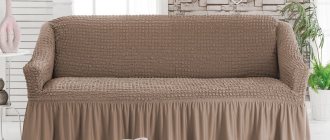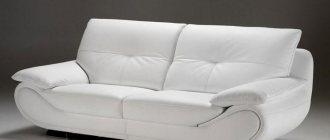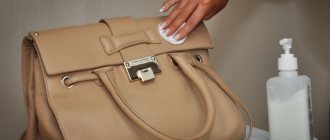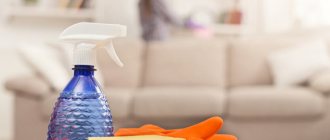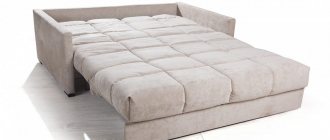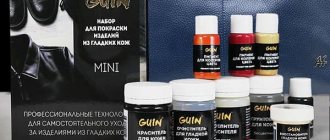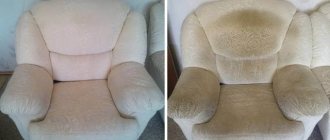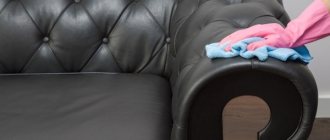It is possible to clean a sofa at home, but you will need to put in a lot of effort to do it without streaks or stains. Be patient and have the right tools. In this article we will talk about different ways to clean a sofa at home with different levels of equipment - rags, sponges, special products and vacuum cleaners. Read and choose which method suits you.
Cleaning the sofa with a vacuum cleaner: instructions and features
There are two types of vacuum cleaners you can use to clean your sofa: regular and washing. A regular model, such as a Thomas vacuum cleaner, is suitable if you first clean the sofa before removing stains. Look at the upholstery and degree of soiling of your sofa and select the appropriate nozzle:
- A simple nozzle is designed for cleaning upholstered furniture. Its peculiarity is that there is no stubble. With its help, the upholstery pile quickly rises, and dust is removed without difficulty;
- The narrow nozzle has a special design. Typically used for professional cleaning of orthopedic mattresses. Cleans even the most difficult to reach places;
- The bristly attachment is a specially designed model. Mainly used to remove pet hair;
- The brush attachment is small in size. Thanks to its long bristles, it can clean even a leather sofa from dirt. Its scope of application is cleaning items with smooth upholstery.
Professional dry cleaning of a sofa at home is different from doing it yourself. Cleaning specialists use more powerful equipment and cleaners and stain removers.
With the help of a washing vacuum cleaner, you can professionally clean your sofa without even contacting specialized services. The cleaning algorithm will be as follows:
- Vacuum your sofa and remove dust and small debris, even in hard-to-reach places.
- Remove stains from upholstery using specialized or homemade stain removers.
- Spray the entire upholstery with sofa cleaner using a spray bottle.
- After 10-15 minutes, unless the instructions for your product indicate otherwise, vacuum the upholstery with a washing vacuum cleaner.
- Repeat if necessary.
- Let the sofa dry.
This cleaning will ensure the brightness of upholstered furniture and renew the upholstery. This method is suitable for cleaning a sofa at home, but you can seek professional sofa cleaning at home.
If you do not want to order dry cleaning of your sofa, you can rent a washing vacuum cleaner for a day. During this time, you can clean all upholstered furniture and mattresses. You can save money if you take a vacuum cleaner for two families - first you clean the furniture, and then your friends.
Pollution prevention
To avoid stains, it is recommended to use capes, blankets or covers. In any furniture store they are presented in a wide range. These capes are easy to remove and wash. In addition, they can be shaken out regularly, which will rid the apartment of dust, pet hair and bacteria. The use of capes and bedspreads is not only hygienic, but also allows you to periodically change the interior.
Buy a removable cover; it can be easily removed from the sofa and washed.
How to clean a sofa without a vacuum cleaner
Even if you don't have a vacuum cleaner, we have a method for you. In this part we will tell you how to quickly and effectively clean a sofa, and try to do it without streaks. Regardless of which cleaning product is chosen, you should read the instructions on the packaging and select the appropriate products for the upholstery. And be patient.
Select a cleaning product based on the type of upholstery. Remember that you cannot clean a leather sofa with the same products as a fabric product.
Each type of upholstery requires the right equipment. It is better to use microfiber cloths. Special rubber brushes have been developed for suede and nubuck. Other types of materials are treated with a foam sponge. It is acceptable to use a brush to clean clothes; Work algorithm:
- Vacuum the product until small specks disappear or shake them off with your hands or a brush. You can also remove small debris with a soft cloth;
- Before starting work, you should test the selected product on an inconspicuous area. Visually there should be no changes in color, and then you can begin to clean other places;
- If there are large stains, remove them first;
- Cleaning all upholstery from dirt and dust should begin with the back, then move on to the armrests. Finally, the seats and the bottom of the sofa are cleaned;
- Apply the sofa cleaner gradually, working on a small area. This takes 30–40 seconds. Then move on to the next step;
- Let the furniture sit for a few minutes. After that, proceed to removing the product;
- Remove the product from the sofa by wiping with a damp cloth well moistened with clean water. To do this efficiently, you will have to repeat the procedure 2-3 times;
- When finished, vacuum the upholstery again to remove any remaining dirt and dry the surface;
- Let the sofa dry.
Before cleaning the sofa, you need to find out what type of upholstery it is. For some materials, soda or a soap composition is used, but in other cases this is undesirable.
Wooden unpolished furniture
It should be remembered that the surface of unpolished furniture is much more susceptible to dirt, since it is not protected by a layer of furniture varnish. Therefore, it must be cleaned regularly, ideally daily, with a vacuum cleaner with a soft bristle attachment.
Brush - vacuum cleaner for cleaning furniture
This will help avoid the accumulation of dust, which gets into the smallest cracks of the wood and gives the furniture an untidy grayish tint. If contamination cannot be avoided, wipe the surface with a damp soft cloth and then wipe dry. Heavy stains can be wiped with soapy water and the remaining residue can be removed immediately with a dry, clean cloth.
Attention! Products for polished furniture should not be used, as they will leave greasy stains that are difficult to remove on the wooden surface.
The video in this article will help you
Dry cleaning the sofa
Dry cleaning a sofa is designed to remove dust and small debris. For this you will need a vacuum cleaner. Dismantle upholstered furniture as much as possible. Remove all pillows and roll-out parts. If you have a narrow nozzle, then use it to vacuum all the joints, seams and hard-to-reach parts of the furniture. If there is no such nozzle, then remove the standard nozzle and just use the tube.
Homemade attachments made from bushings will not help. They are not strong enough for the power of the vacuum cleaner. He pulls their walls inward.
Then, use a regular attachment or a smaller attachment to vacuum the frame, base, and fixed sides of the sofa. After that, move on to the parts that you removed - pillows, roll-out parts. Vacuum them.
While the sofa is disassembled, you can also vacuum the floor under, behind, or inside it.
Method 3. Universal recipe for deep and thorough cleaning (6% vinegar + isopropyl alcohol)
PURPOSE: For general cleaning of old grease and other complex stains of painted and unpainted wooden kitchens, laminated, varnished, plastic glossy facades made of MDF and chipboard, all types of countertops and aprons.
CLEANING FREQUENCY: 1-2 times a year.
INSTRUCTIONS:
Step 1. Mix 6% vinegar with rubbing alcohol (isopropyl) alcohol in a 7:1 ratio and add a few drops of liquid soap to the solution.
Rubbing isopropyl alcohol can be purchased at outlets that sell printer supplies, companies that sell fiber optics, and specialty online stores. You should not experiment with other types of alcohol.
Step 2: Wipe the cabinets with the mixture using a microfiber cloth.
Step 3: Now wipe the kitchen clean with a cloth soaked in warm water.
Step 4. Finally, rub a special wood furniture oil that contains beeswax into all surfaces. This action will “seal” the pores and protect your kitchen from stains, dirt, moisture and grease for a long time.
Cleaning a sofa with a steam cleaner
A steam cleaner allows you to clean your sofa without chemicals. This method can be used as an alternative to a vacuum cleaner and chemicals. It is known that steam can both wash and remove old stains.
The steam cleaner removes harmful microorganisms at a depth of up to 10 cm.
Before using the equipment, you should find out whether the material is resistant to high temperatures. Try cleaning the upholstery from the edge. To thoroughly clean furniture, it is recommended to use different attachments. Use wide brushes to clean the main upholstery, folds, seams and hard-to-reach places using tube attachments. Progress:
- vacuum the sofa first;
- Pour filtered water into the special container of the device;
- add cleaner (as needed).
When processing, it is recommended to stretch the material to make cleaning easier. Using this method, the upholstery is smoothed out, and the sofa takes on a new look.
What if it’s just some water?
In some cases, stains are removed with plain water - without stain removers or folk remedies. This method only works when removing fresh water-soluble stains from the upholstery of a sofa or chair - for example, protein stains (blood, milk) and tannin stains (tea, wine).
Important: protein stains must be washed only with cold water to prevent the protein from curdling.
Wash the upholstery of upholstered furniture with a clean damp cloth or sponge, moving from the edges of the stain to the center. Use a small amount of water so as not to soak the top layer of filler.
When you shouldn’t immediately rinse a stain with water:
► The stain was placed a long time ago. Old stains must first be treated with a stain remover.
► The stain does not dissolve in water (oils, fats, paints, varnishes, chewing gum, wax, paraffin, plasticine). First you need to treat the contamination with a solvent.
► When heavily wet, the upholstery material “shrinks” or loses its performance properties. Water “procedures” are contraindicated for upholstery made of tapestry and silk.
Before dry cleaning
Read the blog:
Don’t do this: the main mistakes when dry cleaning carpets yourself
7 delayed-action problems: what can happen after dry cleaning upholstered furniture
Folk home remedies for cleaning a sofa
Using grandma's methods, cleaning your sofa at home is easy. The main advantage is accessibility. The required ingredients are available in every home.
Folk remedies are inferior in effectiveness to modern chemistry. They also have a specific smell.
To clean your sofa with vinegar you will need:
- 2 tbsp. spoons of table vinegar;
- 1 liter of water.
Add vinegar to hot water. Contaminated areas should be treated with a sponge soaked in the solution. To remove dirt, cover with an unnecessary blanket or blanket. Use a carpet beater or a broom to smooth the surface. This composition effectively eliminates odors. With the help of laundry soap, traces of various liquids can be easily washed away. For example, you can both wash and remove spilled coffee or wine. Simply lather the stained area and then blot with a damp sponge. To wash the sofa without streaks, you should treat all the upholstery and carefully remove all detergents. Therefore, first, spot remove stains, and then wash the entire sofa. Use a spray bottle to treat the surface. Use a cloth and clean water to remove the detergent several times. This method will remove grime from the sofa.
General rules for furniture care
The easiest way to care for furniture is to clean it from dust. Dust is always present in the house, covering all pieces of furniture.
It is necessary to wash furniture from dust with a damp or dry cloth.
How to care for furniture if it has a varnished surface? Lacquered furniture should be washed with a damp cloth with an antistatic agent, then wiped dry.
Features of cleaning sofas made of fabric and leather: what is the difference
Before cleaning the sofa, you need to find out what material is used as upholstery. Usually stronger chemicals are used for upholstery. Most often, for leather furniture, it is enough to remove the stain with a rag. The wrong product, especially for a light leather sofa, can damage it.
Synthetic upholstery
Artificial material does not tolerate high temperatures. When drying with a hairdryer, the structure of the fabric product may be damaged, so it is better to use a wet cleaning method.
Leather upholstery
Products made from eco-leather and leather most often do not require energy-intensive cleaning. As a general rule, it is forbidden to use hard brushes. Before applying the cleaning composition, you need to check how it will act on the upholstery. To do this, test it on a small area.
It is better not to use non-specialized compounds for cleaning leather sofas that are not expressly provided by the manufacturer.
After cleaning eco-leather and leather upholstery, it is advisable to use a wax conditioner. It is strictly not recommended to use a hairdryer on leather products.
Velor upholstery
Do not use a hard brush, as it will damage the velor upholstery. The vacuum cleaner does not harm the lint, so you can use this method constantly. Special compositions have been developed for cleaning velor fabrics. However, if contamination is not removed in a timely manner, the material will lose its presentation. Therefore, surface cleaning is recommended immediately after stains appear.
Suede upholstery
The suede upholstery option is less common on luxury or rare furniture. This material requires a delicate approach. It is better to use a soft bristle brush for cleaning. Purchase specialized products labeled “for suede” or use professional cleaning services.
Precautionary measures
First of all, you need to take care of yourself and your loved ones. The products used in dry cleaning have an alkaline or acidic structure. They do not harm the fabric, but can harm the skin or cause allergies. Therefore, working without rubber gloves is strictly prohibited.
Many detergents contain volatile substances that can cause burns to the mucous membranes. Therefore, it is better to use a mask, even if the room is well ventilated. This rule also applies to homemade solutions using alcohol and ammonia. Volatile compounds of these substances can pick up and transport harmful elements released during the cleaning process through the air.
It is imperative to isolate children during dry cleaning.
Any product, whether made independently or purchased in a store, should first be tried on an inconspicuous part of the furniture. It is better to do this from the back of the sofa. After applying the solution, you should let it dry. If it does not damage the fabric or its coloring, you can safely use the product on the entire surface. There are fabrics for which there are restrictions on the use of certain chemicals:
- Flock is afraid of alcohol.
- Artificial suede and microfiber do not like water. Dry clean only.
- When cleaning jacquard, the temperature of the washing solution should be no more than 40 degrees.
- Plush and velvet can be damaged by aggressive detergents.
- Velor does not tolerate abrasives well.
- When cleaning scotch guard, do not use bleach.
The use of bleaches, acetones, and acids in their pure form is strictly prohibited. They can only be used in small concentrations. Very hot water can age the upholstery, colors will fade, and elasticity will disappear. Apply cleaning solutions only to a sponge or brush, and not to the sofa cover. Light-colored upholstery should only be cleaned with white cloths, otherwise it may become stained. A poorly washed fabric will be destroyed by residual detergents, so you should carefully remove all traces of cleaning.
After studying the simple instructions, everyone will become a specialist no worse than a professional from a cleaning company. If the owner himself takes care of his favorite furniture, he will do a much better job. The money you save can be spent on sweets and eaten with a cup of fragrant coffee, sitting comfortably on a clean, favorite sofa. But at the same time, we should not forget about caution so that we do not have to start dry cleaning at home again.
Cleaning the sofa from odors
During use, furniture can become dirty, resulting in an unpleasant odor. Several techniques have been developed to clean your sofa from unpleasant odors. Also on our website you will find a detailed guide on How to get rid of odor.
The smell of new furniture
A sofa brought from a store often smells of chemicals. This is a pungent specific odor associated with production components - adhesives and paints and varnishes. If the product is delivered in the summer, then you should leave the windows wide open for 2-3 days. During the winter season, other methods are used. You will still have to clean the sofa from the smell, otherwise allergic reactions and discomfort during use are possible. Instructions:
- First, vacuum the furniture to remove sawdust, resin particles, etc.;
- Place odor absorbers under the sofa - absorbents;
- After making sure that the persistent aroma has disappeared, create a draft in the room.
The smell of old furniture
Used items acquire a musty aroma over time. Sofas are no exception. It is known that cleaning a thing is not so difficult, but an integrated approach is needed. Work process:
- First, the sofa must be moved to where there is fresh air;
- Beat out the product and ventilate in a draft;
- Vacuum furniture, including hard-to-reach areas;
- Soak a rag in a solution of water and table vinegar in a ratio of 4:1;
- Carefully treat the surface of the product;
- Finally, cover the sofa with a cloth, for example a sheet, soaked in the same composition;
- Leave for 1–1.5 hours.
If the furniture is in an unheated room, it should be dried. For this purpose, it is better to use a fan heater or similar device. If you smell mold, you should place containers of water near the sofa, and place salt mixed with mint inside. It also happens that not a single method of cleaning a sofa from odor has any effect. This means that the pollution is deeply ingrained. In this case, it is recommended to replace both the filling and the upholstery.
Why 100% dry cleaning results are not guaranteed even by a professional master
A good furniture dry cleaner knows what products need to be used to remove different types of stains and how materials react to different chemical components. But this knowledge does not always help to obtain the expected result.
What difficulties may arise:
► The contamination has a mixed composition (for example, wine + blood + coffee with milk + brilliant green). To remove complex stains, you need different stain removers, which may react “not in the best way” when interacting.
► The stain was “placed” a long time ago. Over time, contaminants become fixed in the structure of the material, and their composition changes. For example, a protein gradually polymerizes to form a water-insoluble substance.
► The old stain mixed with other stains and became difficult to “identify”. In this case, craftsmen have to test different products at random.
► There are other contaminants in the filler under the upholstery that are not visible on the surface. When you try to wash a stain with water, hidden contaminants may appear on the material.
► The filler contains natural tannin-containing materials - for example, coconut fibers. When such materials come into contact with water, brown halos may appear on the upholstery, which become fixed when interacting with alkaline agents.
The result of dry cleaning a sofa depends on the “age” and composition of the stain, as well as the type of material and filling.
What the sofa owner should know before cleaning it themselves:
► Manufacturer’s recommendations for cleaning upholstery material – is it safe from mechanical impact, can solvents be used, how does it react to water, etc.
► Filler composition – whether there are materials made from natural fibers containing tannins.
Return to contents
Read the blog: “5 reasons to agree to turbo drying after dry cleaning a sofa or carpet.”
Cleaning the sofa from child or cat urine stains
In a house where there are small children or cats and other pets, the furniture often gets wet. At the same time, there is no pungent smell of baby urine. It is not advisable to allow urine stains to set in. To remove them, try one of the following methods:
- Laundry soap (72%). You will need a foam sponge. First, lather it, and then rub the dirt until it disappears. After 7–10 minutes, you can rinse the area with water. Dry the trace of baby urine with a hairdryer or blot with a dry cloth/
- Any other detergent. The instructions are the same as with laundry soap, unless otherwise written on the product.
- Lemon juice. You can buy it ready-made at the grocery store. Use a spray bottle to cover the stain evenly. Leave for 20 minutes. Remaining juice is removed with a damp cloth.
Whatever method is chosen, the procedure can be repeated many times until the smell disappears. These methods are suitable for removing urine from children, cats, adults, dogs or other pets.
How to remove stains from fabric upholstery
How to remove stains from a sofa:
- Coffee - glycerin or dry soda.
- Tea - with a napkin soaked in vinegar.
- Blood - cold water with vinegar diluted in it.
- Urine - soda or a solution of lemon juice and vinegar.
- Chocolate - shaving foam or dishwashing liquid.
- Ballpoint pen - a napkin soaked in alcohol.
- Beer - a mixture of salt and soda or a solution of potassium permanganate.
- Grease - with crushed chalk followed by dry cleaning of the surface.
Method 4. Ammonia + warm water
INTENDED USE: For all types of surfaces, but with great care for wooden surfaces.
CLEANING FREQUENCY: if necessary, but not more often than once every two to three months.
INSTRUCTIONS:
Add ammonia to warm water in a 1:1 ratio, then remove dirt with a sponge or spray the product from a spray bottle, wipe the treated area clean with a damp cloth. Finally, dry the surface with a dry soft cloth or microfiber cloth.
